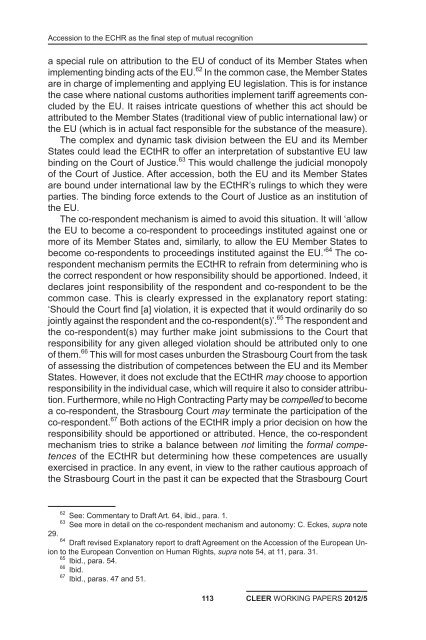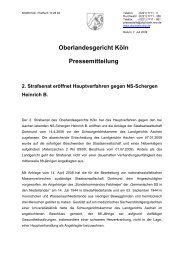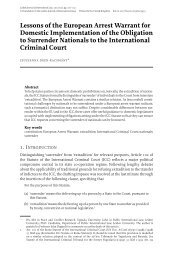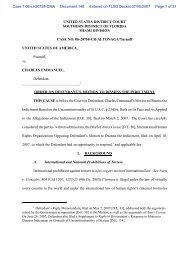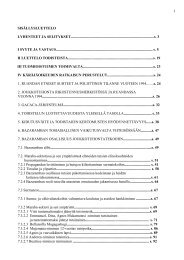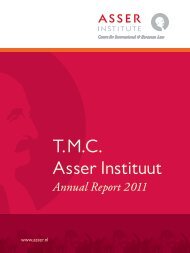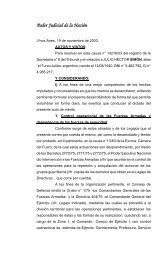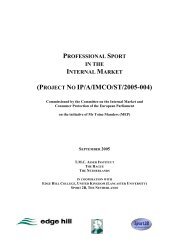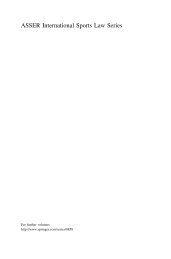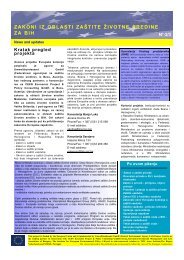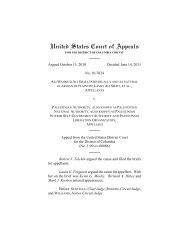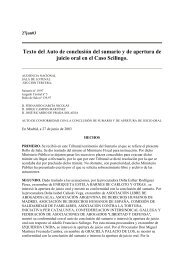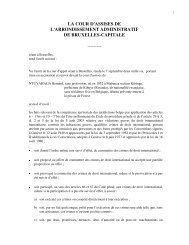Principles and practices of EU external representation - TMC Asser ...
Principles and practices of EU external representation - TMC Asser ...
Principles and practices of EU external representation - TMC Asser ...
Create successful ePaper yourself
Turn your PDF publications into a flip-book with our unique Google optimized e-Paper software.
Accession to the ECHR as the final step <strong>of</strong> mutual recognition<br />
a special rule on attribution to the <strong>EU</strong> <strong>of</strong> conduct <strong>of</strong> its Member States when<br />
implementing binding acts <strong>of</strong> the <strong>EU</strong>. 62 In the common case, the Member States<br />
are in charge <strong>of</strong> implementing <strong>and</strong> applying <strong>EU</strong> legislation. This is for instance<br />
the case where national customs authorities implement tariff agreements concluded<br />
by the <strong>EU</strong>. It raises intricate questions <strong>of</strong> whether this act should be<br />
attributed to the Member States (traditional view <strong>of</strong> public international law) or<br />
the <strong>EU</strong> (which is in actual fact responsible for the substance <strong>of</strong> the measure).<br />
The complex <strong>and</strong> dynamic task division between the <strong>EU</strong> <strong>and</strong> its Member<br />
States could lead the ECtHR to <strong>of</strong>fer an interpretation <strong>of</strong> substantive <strong>EU</strong> law<br />
binding on the Court <strong>of</strong> Justice. 63 This would challenge the judicial monopoly<br />
<strong>of</strong> the Court <strong>of</strong> Justice. After accession, both the <strong>EU</strong> <strong>and</strong> its Member States<br />
are bound under international law by the ECtHR’s rulings to which they were<br />
parties. The binding force extends to the Court <strong>of</strong> Justice as an institution <strong>of</strong><br />
the <strong>EU</strong>.<br />
The co-respondent mechanism is aimed to avoid this situation. It will ‘allow<br />
the <strong>EU</strong> to become a co-respondent to proceedings instituted against one or<br />
more <strong>of</strong> its Member States <strong>and</strong>, similarly, to allow the <strong>EU</strong> Member States to<br />
become co-respondents to proceedings instituted against the <strong>EU</strong>.’ 64 The corespondent<br />
mechanism permits the ECtHR to refrain from determining who is<br />
the correct respondent or how responsibility should be apportioned. Indeed, it<br />
declares joint responsibility <strong>of</strong> the respondent <strong>and</strong> co-respondent to be the<br />
common case. This is clearly expressed in the explanatory report stating:<br />
‘Should the Court find [a] violation, it is expected that it would ordinarily do so<br />
jointly against the respondent <strong>and</strong> the co-respondent(s)’. 65 The respondent <strong>and</strong><br />
the co-respondent(s) may further make joint submissions to the Court that<br />
responsibility for any given alleged violation should be attributed only to one<br />
<strong>of</strong> them. 66 This will for most cases unburden the Strasbourg Court from the task<br />
<strong>of</strong> assessing the distribution <strong>of</strong> competences between the <strong>EU</strong> <strong>and</strong> its Member<br />
States. However, it does not exclude that the ECtHR may choose to apportion<br />
responsibility in the individual case, which will require it also to consider attribution.<br />
Furthermore, while no High Contracting Party may be compelled to become<br />
a co-respondent, the Strasbourg Court may terminate the participation <strong>of</strong> the<br />
co-respondent. 67 Both actions <strong>of</strong> the ECtHR imply a prior decision on how the<br />
responsibility should be apportioned or attributed. Hence, the co-respondent<br />
mechanism tries to strike a balance between not limiting the formal competences<br />
<strong>of</strong> the ECtHR but determining how these competences are usually<br />
exercised in practice. In any event, in view to the rather cautious approach <strong>of</strong><br />
the Strasbourg Court in the past it can be expected that the Strasbourg Court<br />
62 See: Commentary to Draft Art. 64, ibid., para. 1.<br />
63 See more in detail on the co-respondent mechanism <strong>and</strong> autonomy: C. Eckes, supra note<br />
29.<br />
64 Draft revised Explanatory report to draft Agreement on the Accession <strong>of</strong> the European Union<br />
to the European Convention on Human Rights, supra note 54, at 11, para. 31.<br />
65 Ibid., para. 54.<br />
66 Ibid.<br />
67 Ibid., paras. 47 <strong>and</strong> 51.<br />
113<br />
CLEER WORKING PAPERS 2012/5


